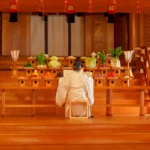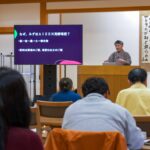By Ruth Reiner
Well I must say that we are reaching now a period in the Japanese modern history that I find personally quite fascinating. We are now getting closer to the second World War, and Oomoto’s stance on the occurrences. I think that one of the most interesting aspects of this critical stage in modern Japan, is its social – psychological outcomes. We will be entering with Oomoto, step by step on this strange path leading to World War 2, touching a bit of its social preconditions and social outcomes
I find the issue of the second World War, all in all, an interesting subject to talk about with religious Japanese people. Actually just a few days ago, I spoke about the war with a Shinto priest (not an Oomoto priest), who is in his late 20’s.
He was emphasizing that the war on the side of Japan was not an Invasion war as regarded later by the US, but a war of no choice, or rather an essential war. I found it quite fascinating to know that the next day he was off to Tokyo to take part in an emergency meeting of representatives of different Shinto Shrines and sects from around Japan that were to be discussing the present situation concerning Japanese patriotism.
This meeting was initiated after a tragic scene had occurred in Hiroshima not long ago. The scene took place at a school. There was a discussion among the teachers regarding having the national flag put up and about singing the national anthem in a graduation party, for that school’s students. Most teachers voted against it. The teachers opposed because of their assosiation of the flag and the National anthem with the Japanese war effort. This case resulted in the suicide of the schools Head Maste who was under the pressure of the Japanese Ministry of Education on one hand, and the teachers stance on the other hand.
Soon after, this organization of Shinto priests, including this young priest, was invited to discuss what role they can take in this state that Japan is in. Just to make things clear as I understand it, the problem is seen in the act of the teachers who refused the National anthem and flag, not the man who had committed suicide.
It seems to me like in Japan there are things that still have not been solved in the hearts of many, regarding the war and its outcomes. But I guess, coming from Israel, a country that experienced many wars, I should know that people actually never get over this horrific phenomenon, war.
So many times, I read books written by foreigners discussing these social psychological effects. I found it quite fascinating to read about it in our book, “The Great Onisaburo Deguchi”, where these issues discussed from the Oomoto point of view, which maybe unique in it’s way, and not necessarily part of the main stream. Infact at that time it was rather suppressed by the main stream.
So let’s get back to the book. We have talked a bit about the “Second Golden Age of Oomoto”, in last item. It was among other things characterized by a great amount of publications distributed all around the world, the ‘Universal Love and Brotherhood Association’, founded by Onisaburo, and institutions such as the “Aizen Hall”, “Aizen Club”, “Aizen Clinic”, and others that sprang up in various countries in the world. But it also had to come to an end like any other good thing in life.
The light started dimming as the 1930’s began. In chapter 33 of “The Great Onisaburo Deguchi”, Kyotaro Deguchi, the writer, talks about an interesting numerological point that had been made by Onisaburo Deguchi in 1931:
“This year, he said, is 1931 according to the Western calendar, and therefor the beginning of the war (in Japanese the numerals 1,9 and 3 can be read I-ku-sa, which means war, and the final one can be read hajime, which means beginning).”
Then Kyotaro Deguchi chooses to present us with an absolutely disturbing article that appeared around the same period in an American Magazine called “Liberty”, under the heading “We Are Ready for war with Japan.”:
“The article was all the more disturbing since it was written by the American General William Mitchell, an authority of the US Air Force. The article contained such frightening passages as: ‘It is the might of our air force that the Japanese are afraid of. Geographically, Japan presents an ideal target… Bombs dropped from the air would burn out the towns, and poison gas spreading through the villages would be sure to kill everyone.”
So anyway as you see the heat has been turned up a bit. At this point, as war was already “written on the wall”, Oomoto went into a very high gear, with the aim of trying to avoid the obvious tragedy that hung over Japan …
Onisaburo declared that it is a state of emergency, and as Mr. Kyotaro Deguchi notes in chapter 33, soon it would be the second great advance of Oomoto into society. The first refers to the reconstruction theory that I mentioned in the item referring to the first Golden Age of Oomoto. Mr. Kyotaro Deguchi explains here in chapter 33 that this time Oomoto’s strategies had changed, since the first “campaign” was, as he sees it, a failure. This time “…instead of just straight proclaiming their case, they were to appeal to the people in a slightly roundabout way”. (ch 33)
Well that will be all for today, but next time we will shift gears, and go up the steep road, as Oomoto goes with full strength, and finally…. Well you will just have to wait and read what finally happened.



